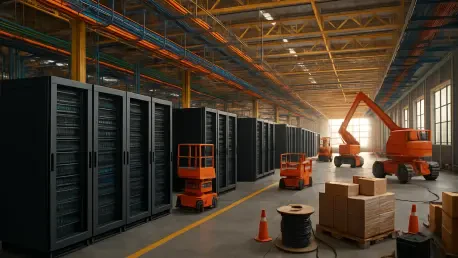In an era where digital transformation drives economic progress, the infrastructure and construction industry stands at a pivotal crossroads, with data centers emerging as the backbone of global connectivity. Jacobs, a Dallas-based titan in this sector, has recently unveiled its fiscal Q4 earnings, revealing a striking contrast between a sharp profit decline and a robust revenue increase, underpinned by an unprecedented boom in data center demand. This report delves into the intricacies of these financial outcomes, exploring how the surge in advanced infrastructure projects positions the company as a key player in shaping the technological landscape.
Overview of Jacobs’ Fiscal Performance and Industry Context
Jacobs holds a commanding presence in the construction and infrastructure arena, delivering critical solutions from its headquarters in Dallas. Known for tackling complex projects, the company spans a wide array of sectors, including transportation, water management, and cutting-edge facilities for technology and life sciences. Its expertise places it at the forefront of an industry increasingly driven by the need for robust, scalable infrastructure to support rapid urbanization and digital expansion.
The data center and advanced infrastructure sectors have become linchpins of global economic growth, fueled by the relentless demand for cloud computing, artificial intelligence, and big data analytics. These facilities are not merely buildings but vital components in the wheel of technological advancement, enabling everything from streaming services to smart cities. As businesses and governments prioritize digital resilience, the market for such infrastructure continues to soar, with significant implications for economic stability and innovation.
Key industry segments like data centers, semiconductors, life sciences, water, and transportation are witnessing transformative growth, driven by technological trends such as edge computing and sustainable design. Major players, alongside Jacobs, are racing to meet this demand, with competition intensifying among firms like Bechtel and AECOM. The convergence of environmental considerations and digital needs is reshaping project priorities, pushing companies to adopt smarter, greener solutions to stay competitive.
Deep Dive into Jacobs’ Q4 Financial Results and Sector Growth
Key Financial Metrics and Performance Highlights
Jacobs’ fiscal Q4 earnings paint a mixed picture, with profit taking a substantial hit, dropping 62% to $122.25 million compared to the prior year. This decline raises concerns among stakeholders, reflecting challenges in maintaining profitability amid rising operational costs. Despite this setback, the company’s revenue tells a more optimistic story, climbing 6.4% to $3.15 billion, a clear indicator of sustained market demand for its services.
A standout metric from the earnings report is the record backlog of $23.06 billion, marking a 5.5% increase from the previous year. This figure underscores a strong pipeline of future projects, signaling confidence in Jacobs’ ability to secure long-term contracts across diverse sectors. Such a backlog suggests that the company is well-positioned to weather short-term financial hiccups and capitalize on emerging opportunities.
Analyst perspectives provide further context, with Baird’s Andrew Wittmann noting that while free cash flow remains a concern, the overall earnings reflect stable growth. His assessment highlights the resilience of Jacobs’ business model, even as profitability faces headwinds. This balance between immediate challenges and long-term potential remains a focal point for investors monitoring the company’s trajectory.
Sector-Specific Trends and Pipeline Expansion
The data center sector is experiencing a historic surge for Jacobs, with its pipeline expanding fivefold in the latest quarter. This growth is propelled by a strategic pivot into “gray space”—the supporting infrastructure critical for power and cooling—beyond traditional equipment areas, bolstered by a partnership with Nvidia. Such expansion reflects the escalating need for facilities that can handle the computational demands of modern technology.
Other sectors are also contributing significantly to Jacobs’ momentum, with the U.S. semiconductor pipeline growing by 20%, driven by high-bandwidth memory projects. The life sciences segment has seen a 50% pipeline increase domestically, indicative of rising demand for specialized research and manufacturing facilities. Globally, water projects have surged by 50%, positioning Jacobs as a leader in addressing critical resource management needs.
Geographic diversity adds another layer to this growth narrative, with strong U.S. demand for data centers complemented by rising interest in the Middle East and Europe. Additionally, transportation infrastructure remains a key contributor, exemplified by a $166 million contract for the Interborough Express in New York City, a transformative light rail project. These developments highlight Jacobs’ ability to tap into varied markets and project types to fuel its expansion.
Challenges Facing Jacobs and the Infrastructure Sector
Financial hurdles loom large for Jacobs, with the steep Q4 profit decline signaling potential vulnerabilities in cost management or project execution. Analysts have pointed to weaker free cash flow as a lingering issue, which could constrain the company’s ability to fund new initiatives without external financing. These fiscal pressures underscore the need for tighter operational efficiencies in an increasingly competitive landscape.
Beyond internal challenges, the broader infrastructure sector grapples with systemic obstacles that threaten project timelines and profitability. Supply chain disruptions continue to delay material deliveries, while labor shortages exacerbate workforce constraints, driving up costs. Rising material prices further compound these issues, forcing companies to reassess budgets and timelines to maintain viability.
To navigate these headwinds, diversification across sectors offers a viable strategy for Jacobs, reducing reliance on any single market prone to volatility. Strategic partnerships, such as the collaboration with Nvidia, also provide a buffer by enhancing technological capabilities and market reach. By adopting such measures, the company can mitigate risks and sustain growth momentum even in turbulent times.
Regulatory and Compliance Considerations in Infrastructure Development
The regulatory landscape for data centers and infrastructure projects is complex, with environmental standards playing a central role in shaping development practices. Stricter emissions guidelines and energy efficiency mandates require companies to integrate sustainable solutions, often increasing upfront costs. Local zoning laws add another layer of scrutiny, influencing site selection and project design to align with community needs.
Compliance is particularly critical in sectors like water and energy, where sustainable development is not just a regulatory requirement but a public expectation. Failure to meet these standards can delay approvals, inflate expenses, or even halt projects altogether. Jacobs must balance these obligations with the urgency of meeting global demand, ensuring that environmental considerations do not derail operational goals.
Navigating this intricate web of regulations demands a proactive approach, with Jacobs leveraging its expertise to streamline permitting processes and adopt innovative practices. By prioritizing sustainability in project planning, the company maintains operational efficiency while addressing stakeholder concerns. This adaptability is essential for sustaining growth in a sector where compliance can make or break success.
Future Outlook for Jacobs and the Data Center Boom
Looking ahead, Jacobs appears poised for continued growth, with data centers and life sciences emerging as primary engines of expansion. Sustained demand in these areas, coupled with potential acceleration in semiconductor projects, could drive the company toward the higher end of its growth projections. CEO Bob Pragada’s optimism reflects confidence in maintaining this upward trajectory through strategic focus.
Emerging trends, such as the global push for digital infrastructure and sustainable initiatives, are set to further propel market expansion. The proliferation of smart technologies and renewable energy integration in projects signals a shift toward more resilient and eco-friendly infrastructure. Jacobs’ ability to align with these priorities will be crucial in capturing new opportunities across regions.
However, potential disruptors like economic fluctuations or rapid technological advancements could pose risks to this outlook. To counter such challenges, Jacobs’ diversified portfolio across multiple sectors provides a safety net, while its commitment to innovation ensures adaptability. This dual approach positions the company to thrive amid uncertainty, capitalizing on both current strengths and future possibilities.
Conclusion
Reflecting on Jacobs’ Q4 earnings, the stark contrast between a significant profit drop and robust revenue growth paints a nuanced picture of the company’s financial health. The record backlog and explosive growth in the data center pipeline stand out as testaments to its strategic foresight, despite industry-wide challenges like supply chain disruptions and regulatory complexities. These achievements underscore Jacobs’ pivotal role in advancing global infrastructure.
Moving forward, a key consideration for Jacobs is to strengthen financial resilience by addressing free cash flow concerns through optimized cost structures. Exploring deeper investments in sustainable technologies offers a pathway to align with regulatory demands and market expectations. By focusing on these actionable steps, Jacobs positions itself to not only navigate immediate hurdles but also lead the charge in shaping the future of digital and sustainable infrastructure development.









